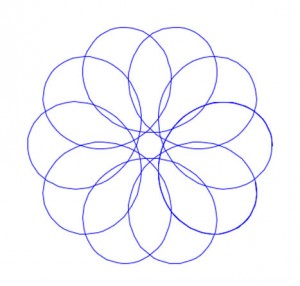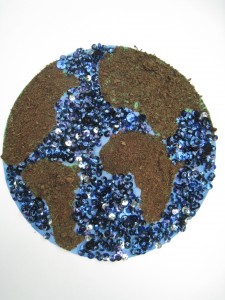Whirling Dervish
ø
After learning about the Whirling Dervishes of Turkey in class and viewing videos of sama, I wanted to portray the design that might be left on the floor after they were done, as if they were figure skaters creating a pattern. I used a Spirograph computer program. In an effort to respond to the esoteric, emotional, and ecstatic nature of devotion, each dervish spins in a circular fashion and moves around the floor in a circle. The dervishes together move as a circle. The above design reflects both each individual and the entire group, resulting in an overall circular pattern with interlacing parts.
This form of Sufi devotion, the Mevlevi order, was begun by Rumi’s son, Sultan Walad. It relates to the primordial nature of man, before language was created, when man connected to God through wordless action and feeling. Each person has the ability to connect with God without an intercessor. Sufi devotion is a way to do this. The Qur’an verse 2:115 seems to speak to this: “To God belongs the East and the West; so wherever you turn, there will be the face of God.” By turning in every direction one is able to see God. For the dervishes the dance acts as a form of meditation.
The resulting circular pattern relates to the circular, inclusive nature of the cosmos, seemingly without beginning or end. This could be understood to be the relationship we each can have with God, as well, giving Him praise and receiving his blessings in an endless cycle. Each individual’s relationship with God can also intersect with other devotees as evidenced by the intersecting circles.
This image is printed on white paper, symbolizing the white garments of the dancers that represent burial shrouds of the physical world and the creation of a spiritual existence. Rather than using black ink, which could have represented the robes the dancers discard before the dance but which would have inappropriately remained on the paper, I instead chose blue ink, which stands for protection by God.




